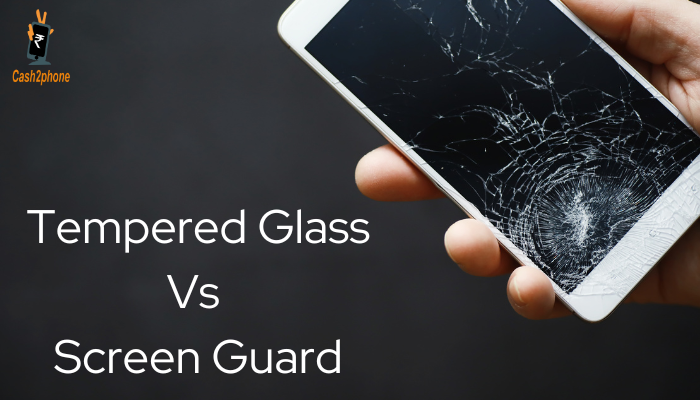Tempered glass protectors have a 9H hardness rating, meaning they can protect your screen against everyday scuffs and scratches. On the other hand, liquid protectors can’t resist more severe damage, especially if you drop your phone on some particularly sharp object.
A tempered glass protector also feels more like your phone’s screen than a plastic one. This means it’s more pleasant to use and shouldn’t irritate your fingers when scrolling through your apps.
Enhanced Durability and Impact Resistance
Screen protectors made of tempered glass are typically thicker and more durable than those designed with plastic film. They are less likely to crack or break into dangerous shards. They can resist damage from abrasion, etching, and other everyday wear and tear. Tempered glass protectors often feature advanced oleophobic coatings that resist fingerprint smudges and oil residue.
Tempered glass also offers superior impact resistance compared to plastic film screen protectors. When dropped, the tempered glass absorbs the shock and prevents a direct blow to the smartphone’s display. This significantly reduces the risk of serious damage that can potentially be caused by a single drop or multiple impacts in quick succession.
350+ Instagram Bio for Girls: Be the Trendsetter, Not the Follower
When selecting a tempered glass screen protector, consider the level of protection you need based on your lifestyle and typical environment. Suppose you frequently engage in physical activities or work in a hands-on environment. In that case, a thicker tempered glass protector might be necessary to protect your smartphone from more severe accidents. However, even a thinner glass protector can offer significant protection from scratches and other types of damage.
Seamless Touch Sensitivity
Unlike plastic screen protectors, which are thin and prone to failure, glass-tempered screen protectors provide a smoother glide for your fingertips. They are also more resistant to heavy impacts and can protect your phone from serious damage. In addition, they can maintain display brightness.
Tempered glass screen protectors are made by heating the glass extensively and cooling it quickly. This process results in the glass becoming exceptionally strong and scratch-resistant. They are also smooth to the touch and offer optimal image clarity. They are also extremely durable and can resist fingerprint smudges, common on smartphone screens.
OnePlus Bullets Wireless Z2 ANC Price and Specifications in India
However, many manufacturers claim that their liquid screen protectors can seep into all the microscopic nooks and crannies of your smartphone’s surface. This is said to make them superior to traditional solid protectors. YouTuber Arun Maini of Mrwhosetheboss recently tested this claim but found that the liquid protectors could have made a difference regarding touchscreen sensitivity. This is because a smartphone screen’s roughness is due to its coating’s microstructure and not its surface texture.
Advanced Oleophobic Coating for Smudge Resistance
Screen glass protectors feature an advanced oleophobic coating that keeps your screen clear of fingerprints and smudges. It helps maintain pristine image quality for longer and makes cleaning easier. The oleophobic coating is applied to the surface of the glass through vacuum or vapor deposition processes. It consists of several layers, including PDDA, an easily degradable polymer that adheres well to the glass substrate, and silica nanoparticles with known wear resistance. The oleophobic layer is then sealed to the glass using an anti-reflection coating.
This is what helps to make tempered glass so much more durable than conventional screen protectors. You can test for the presence of oleophobic coating by dropping a drop of water on the screen. The oleophobic coating is in good condition if it forms a spherical shape and does not squish.
However, the oleophobic coating will gradually wear off with regular use and exposure to harsh chemicals or abrasive materials. If this happens, you will need to replace your screen protector. The oleophobic coating feel is something that many users appreciate as it gives their gadgets a smooth, premium look and feel.
Curved Edge Protection
A tempered glass screen protector has the advantage of being able to cover the entire edge of your device’s display. This protects your phone against damage from bumping or banging into other surfaces and prevents your device from getting chipped if it falls face down.
This is not always possible with liquid plastic protectors, which only offer a small strip around the edge of the display. This is one of the major advantages of a glass protector over the competition.
Many tempered glass screen protectors have an anti-glare coating that cuts down on reflected light from fluorescent lighting or sunlight, making your smartphone easier to use. This feature allows your eyes to strain less when using your smartphone and can make you more productive in the workplace or outdoors.
The oleophobic and anti-glare features are not available with all glass protectors, so you should pay attention to the fine print. Cheaper screen protectors have the oleophobic coating sprayed on. In contrast, expensive ones have it statically applied to the surface of the glass. This also makes a difference in how your fingers run over the screen since the coatings have different properties.
Full Coverage Options
A screen protector is a great way to help your smartphone look new for a long time. A flawless screen also increases the resale value of your device and provides an overall more appealing visual aesthetic experience. While a screen protector can take care of scratches and minor drops, it may not be enough to protect your phone from a severe drop on a rough surface or from an impact that breaks the glass into jagged shards.
Another thing to consider with plastic screen protectors is that they typically leave open spaces on the curved edges of your device that can trap dust, dirt, and tiny rocks that can scratch your display or damage your buttons. Using a tempered glass screen protector with rounded edges can eliminate this issue and keep your mobile phone safe and looking its best for longer.
Another key feature of tempered glass is that it usually feels more similar to your smartphone display than a plastic screen protector. This makes your fingers run more smoothly over the display, and this is one reason why glass screen protectors are preferred by many users.
Easy Application and Bubble-Free Installation
When choosing a screen protector, looking for one that will easily stick to your device and have a bubble-free installation process is important. This will make it easier to prevent mistakes that could leave the protective film exposed to damage and make your device susceptible to fingerprints and smudges.
Tempered glass screen protectors are easy to apply. They come with a wet application method that makes it simple to position the protector and avoid bubbles. They also offer better protection against scratches and light impacts than plastic protectors and are more durable and long-lasting.
Tempered glass protectors have higher transparency and clarity than plastic ones, which can distort or reduce the quality of your device’s display. They also resist scratching and can improve the touch sensitivity of your device’s touchscreen. Moreover, some models have an anti-glare coating that diffuses the harsh effects of fluorescent lighting or sunlight on your screen. They are the perfect choice for anyone who wants to protect their device from unwanted glare and light.
Longevity and Scratch-Resistant Features
Smartphones today come with Gorilla Glass or Dragontrail that are resistant to scratches. However, they are not scratch-proof and require a screen protector for added protection. While a screen protector cannot make your phone unbreakable, it is the safest and most economical way to protect your device against everyday wear and tear.
Maximizing Productivity with Your Smartphone: Top Apps and Hacks for Efficiency
Tempered glass protectors are thicker and protect more against heavy impacts and scratches. They also retain excellent clarity, giving your device a feel similar to your phone’s original screen. On the downside, these protectors tend to be heavier and more expensive.
Plastic screen protectors are much thinner than tempered glass. They can be easily scratched by keys in your pocket or other items. They may also interfere with your touch sensitivity and reduce the response time of your touchscreen.
Polyurethane film protectors are durable, optically clear, and easy to install. They also have good scratch resistance and self-healing properties that can repair minor scratches. Some are even designed with additional features, such as anti-glare and privacy filters.
Comparative Pricing and Value for Protection
While tempered glass screen protectors are more expensive than plastic ones, they offer superior protection. These thicker protectors are harder to damage and boast 9H hardness. In addition, they protect against smudges and fingerprints, making them ideal for users who spend a lot of time with their phones in their hands.
If you prefer a more lightweight protector, opt for a polymer one. These protectors are made from an environmentally friendly, sustainable material that comes in various texture options. These protectors are also more affordable than tempered glass.
Want to earn cash for your old Phone ? Choose Cash2Phone for top value. Hassle-free selling, fair prices. Visit us now!



Leave a Reply